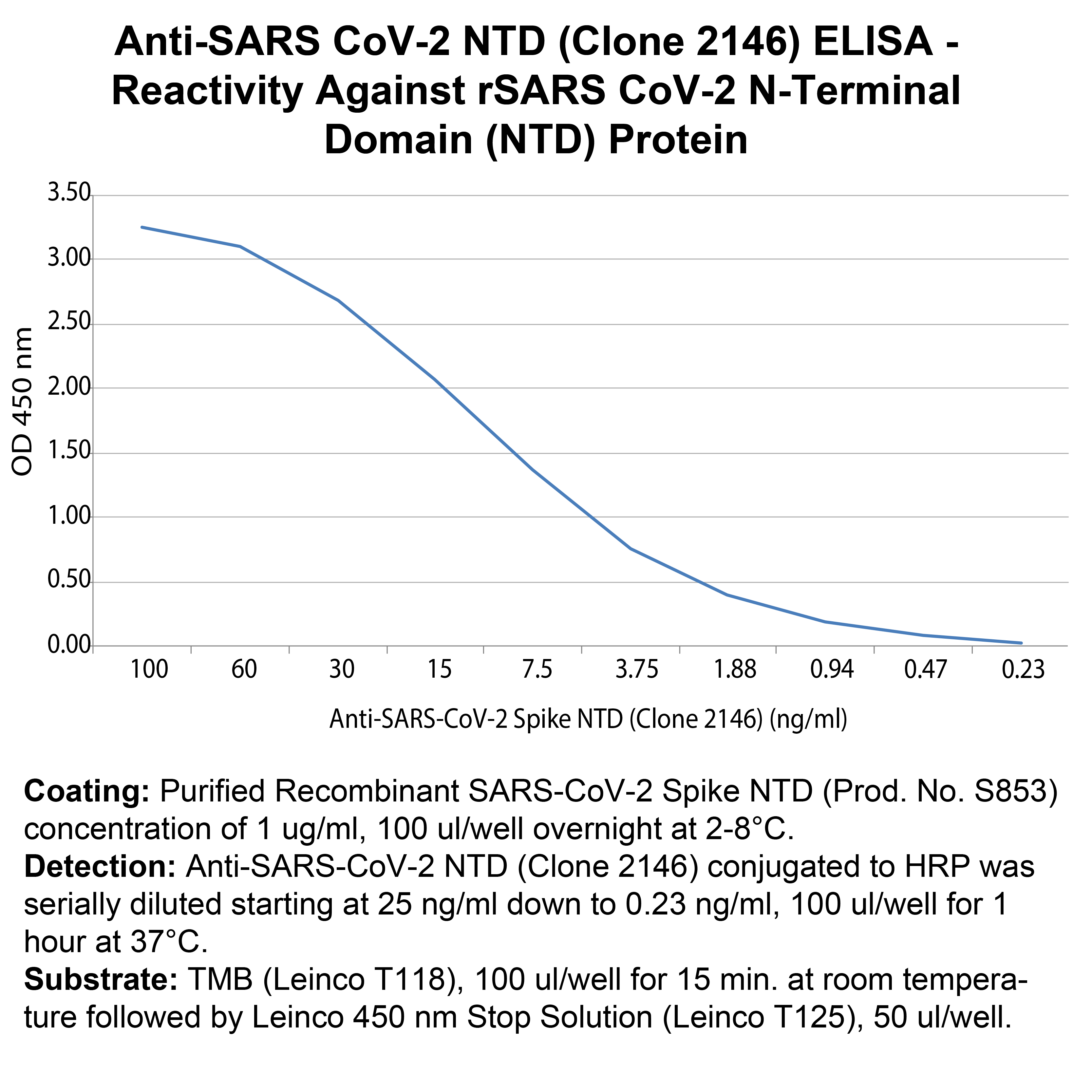Anti-SARS-CoV-2 Spike NTD (Clone 2146) - Biotin
| Code | Size | Price |
|---|
| LEI-LT2005-50ug | 50 ug | £262.00 |
Quantity:
Prices exclude any Taxes / VAT
Overview
Host Type: Virus
Antibody Isotype: Human IgG1
Antibody Clonality: Monoclonal
Antibody Clone: 2146
Regulatory Status: RUO
Target Species:
- SARS-CoV-2
- Virus
Applications:
- Enzyme-Linked Immunosorbent Assay (ELISA)
- Immunohistochemistry (IHC)
Shipping:
Blue Ice
Storage:
This biotinylated mon°Clonal antibody is stable when stored at 2-8°C. Do not freeze.
Images
Further Information
Antigen Distribution:
The spike NTD is expressed on the surface of the SARS-CoV-2 virus.
Concentration:
0.5 mg/ml
Conjugate/Tag/Label:
Biotin
Format:
This recombinant biotinylated antibody is formulated in 0.01 M phosphate buffered saline (150 mM NaCl) PBS pH 7.4, 1% BSA and 0.09% sodium azide as a preservative.
Formulation:
This recombinant biotinylated antibody is formulated in 0.01 M phosphate buffered saline (150 mM NaCl) PBS pH 7.4, 1% BSA and 0.09% sodium azide as a preservative.
Immunogen:
Sequenced from human survivors of COVID-19 (SARS-CoV-2)
Long Description:
Severe acute respiratory syndrome coronavirus 2 (SARS-CoV-2), the causative agent of coronavirus disease 2019 (COVID-19), is an enveloped, single-stranded, positive-sense RNA virus that belongs to the Coronaviridae family 1. The SARS-CoV-2 genome, which shares 79.6% identity with SARS-CoV, encodes four essential structural proteins: the spike (S), envelope (E), membrane (M), and nucleocapsid protein (N) 2. The S protein is a transmembrane, homotrimeric, class I fusion glycoprotein that mediates viral attachment, fusion, and entry into host cells 3. Each ~180 kDa monomer contains two functional subunits, S1 (~700 a.a) and S2 (~600 a.a), that mediate viral attachment and membrane fusion, respectively. S1 contains two major domains, the N-terminal (NTD) and C-terminal domains (CTD). In both SARS-CoV and SARS-CoV-2, the CTD contains the receptor-binding domain (RBD), which binds to the angiotensin-converting enzyme 2 (ACE2) receptor on host cells3-5. The NTD of SARS-CoV-2 does not bind to ACE26, and the function of NTD in SARS-CoV-2 infection is not well understood. In other CoVs, the NTD may promote attachment by binding to sugar moieties7 and might play a role in the conformational change of S2 required for membrane fusion8. While most neutralizing antibodies target the RBD domain and block receptor binding, potent neutralizing antibodies targeting NTD were isolated from convalescent COVID19 patients9, identifying the NTD as an attractive candidate for vaccines and therapeutics. In addition, the NTD is a promising antigen for diagnostic tests, as there is only 53.5% homology between the NTD of SARS-CoV-2 and SARS-CoV10.
NCBI Gene:
43740568
Target:
SARS-CoV-2 Spike NTD
References
1. Zhou, P., Yang, X., Wang, X. et al. Nature 579, 270?273. 2020.
2. Wu, F., Zhao, S., Yu, B. et al. Nature 579, 265?269. 2020.
3. Wrapp D, Wang N, Corbett KS, et al. bioRxiv. 2020.
4. Walls AC, Park YJ, Tortorici MA, et al. Cell. 181(2):281-292.e6. 2020.
5. Li W, Zhang C, Sui J, et al. EMBO J. 24(8):1634-1643. 2020.
6. Wang Q, Zhang Y, Wu L, et al. Cell. 181(4):894-904.e9. 2020.
7. Park, Y., Walls, A.C., Wang, Z. et al. Nat Struct Mol Biol 26, 1151?1157. 2019.
8. Zhou, H., Chen, Y., Zhang, S. et al. Nat Commun 10, 3068. 2019.
9. Chi X, Yan R, Zhang J, et al. Science. eabc6952. 2020.
10. Ou, X., Liu, Y., Lei, X. et al. Nat Commun 11, 1620. 2020.



